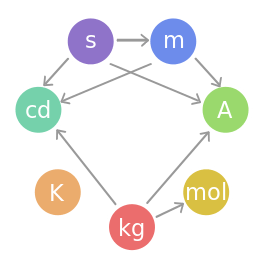International System of Quantities
The International System of Quantities (ISQ) is a system based on seven base quantities: length, mass, time, electric current, thermodynamic temperature, amount of substance, and luminous intensity. Other quantities such as area, pressure, and electrical resistance are derived from these base quantities by clear, non-contradictory equations. The ISQ defines the quantities that are measured with the SI units[1] and also includes many other quantities in modern science and technology.[2] The ISQ is defined in the international standard ISO/IEC 80000, and was finalised in 2009 with the publication of ISO 80000-1.[3]
The 14 parts of ISO/IEC 80000 define quantities used in scientific disciplines such as mechanics, light, acoustics (e.g., sound pressure and sound intensity), electromagnetism, information technology (e.g., traffic intensity and storage capacity), chemistry, mathematics, and physiology.
Base quantities
A base quantity is a physical quantity in a subset of a given system of quantities that is chosen by convention, where no quantity in the set can be expressed in terms of the others. The ISQ defines seven base quantities. The symbols for them, as for other quantities, are written in italics.[4]
The dimension of a physical quantity does not include magnitude or units. The conventional symbolic representation of the dimension of a base quantity is a single upper-case letter in roman (upright) sans-serif[5] type.
Base quantity Symbol for quantity[6] Symbol for dimension SI unit[6] length l L metre mass m M kilogram time t T second electric current I I ampere thermodynamic temperature T Θ kelvin amount of substance n N mole luminous intensity Iv J candela
Derived quantities
A derived quantity is a quantity in a system of quantities that is a defined in terms of the base quantities of that system. The ISQ defines many derived quantities.
Dimensions of derived quantities
The conventional symbolic representation of the dimension of a derived quantity is the product of powers of the dimensions of the base quantities according to the definition of the derived quantity. The dimension of a quantity is denoted by LaMbTcIdΘeNfJg, where the exponents, named dimensional exponents, are positive, negative, or zero. The symbol may be omitted if its exponent is zero. For example, in the ISQ, the quantity dimension of velocity is denoted LT−1. The following table lists some quantities defined by the ISQ.
A quantity of dimension one is historically known as a dimensionless quantity (a term that is still commonly used), all its dimensional exponents are zero and its dimension symbol is 1. Such a quantity can be regarded as a derived quantity in the form of the ratio of two quantities of the same dimension.
Derived quantity Symbol for dimension plane angle 1 solid angle 1 frequency T−1 force MLT−2 pressure ML−1T−2 velocity LT−1 area L2 volume L3 acceleration LT−2
Logarithmic quantities
In the ISQ, the level of a quantity Q is defined as logr(Q/Q0), where r is a specified base and Q0 is a specified reference value of the quantity. An example of level is sound pressure level. All levels of the ISQ are derived quantities.
References
- ↑ "1.16". International vocabulary of metrology – Basic and general concepts and associated terms (VIM) (PDF) (3rd ed.). International Bureau of Weights and Measures (BIPM):Joint Committee for Guides in Metrology. 2012. Retrieved 28 March 2015.
- ↑ ISO 80000-1 Quantities and units. Part 1: General (1st ed.). Switzerland: ISO (the International Organization for Standardization). 2009-11-15. p. vi. Retrieved 23 May 2015.
- ↑ S. V. Gupta, Units of Measurement: Past, Present and Future. International System of Units, p. 16, Springer, 2009 ISBN 3-642-00738-4.
- ↑ ISO 80000-1:2009
- ↑ The status of the requirement for sans-serif is not as clear, since ISO 80000-1:2009 makes no mention of it ("The conventional symbolic representation of the dimension of a base quantity is a single upper case letter in roman (upright) type.") whereas the secondary source BIPM JCGM 200:2012 does ("The conventional symbolic representation of the dimension of a base quantity is a single upper case letter in roman (upright) sans-serif type.").
- 1 2 The associated symbol and SI unit are given here for reference only; they do not form part of the ISQ.
Further reading
- B. N. Taylor, Ambler Thompson, International System of Units (SI), National Institute of Standards and Technology 2008 edition, ISBN 1-4379-1558-2.
